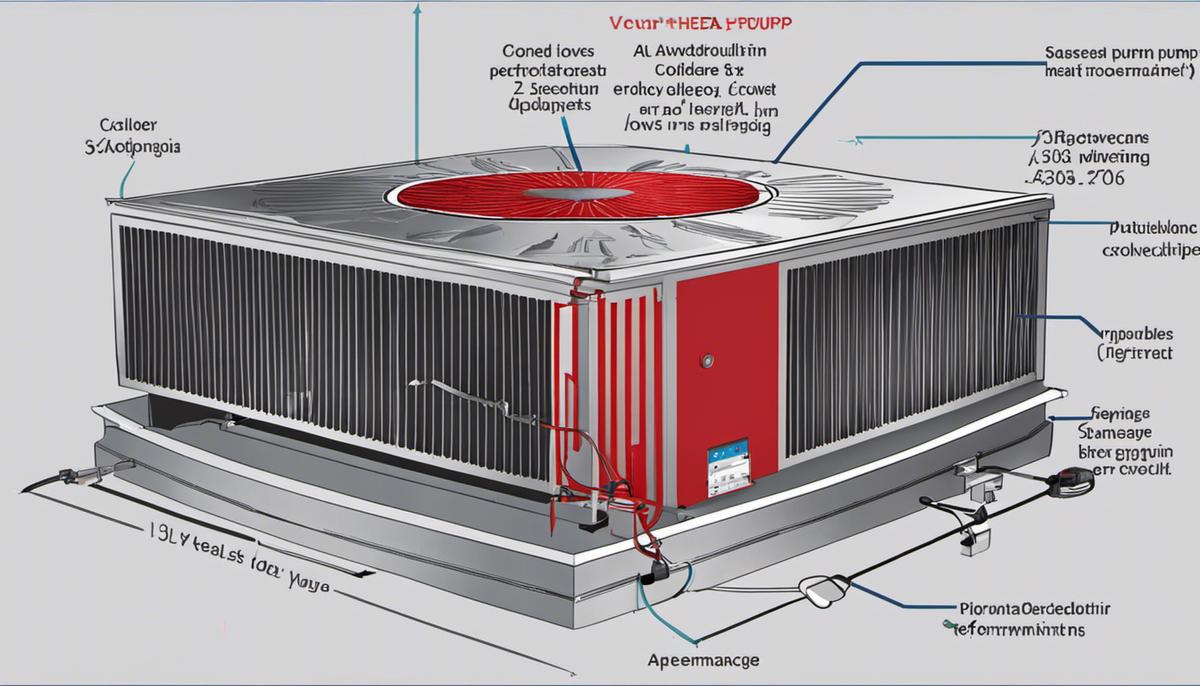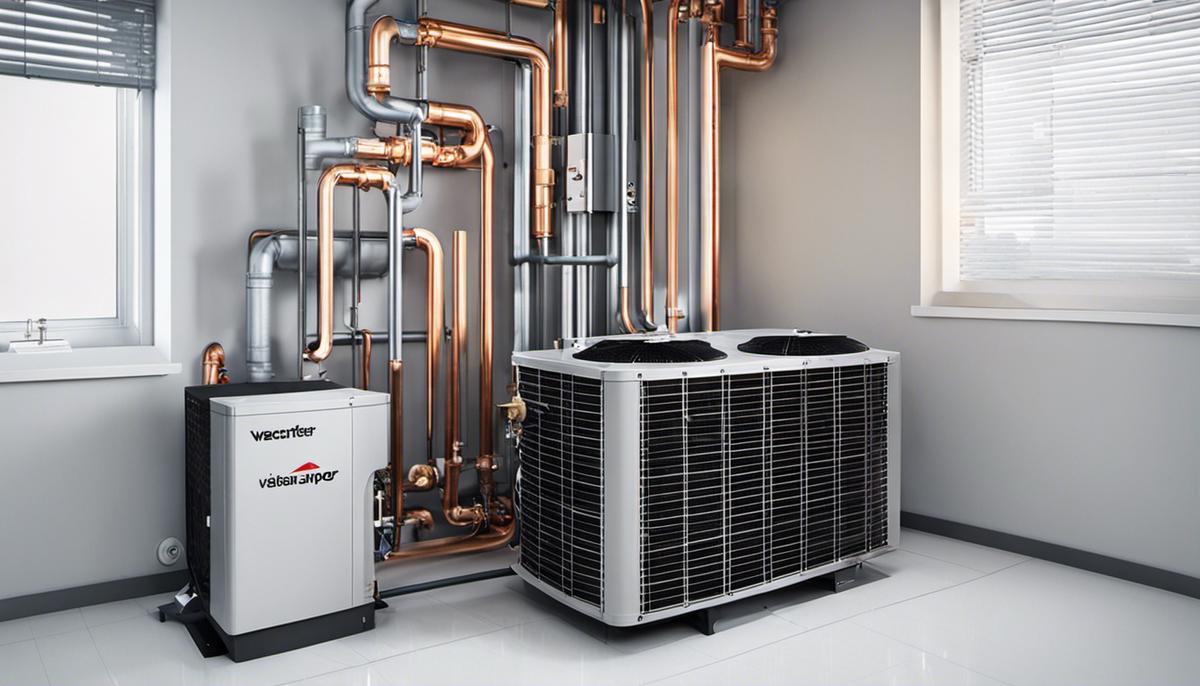As we push the boundaries of technological advancements with the aim of bettering our existence, the need to find more efficient heat sourcing methods becomes more urgent, particularly in frigid climates. Heat pumps, a cornerstone of sustainable heating technology, provide a viable alternative but raise questions about their efficiency in extreme cold climates. This discourse unravels the science behind heat pump operations, the efficiency of such systems in colder regions, and the cutting-edge innovations currently reshaping this technology. Moreover, it contrasts heat pumps with traditional heating systems and reviews practical guides for the maintenance and troubleshooting of these pumps in frigid environments, to provide a comprehensive understanding of this vital technology.
Table of Contents
Principles of Heat Pump Operations
The operation of heat pumps, a cornerstone of thermodynamic applications in contemporary technology, hinges on fundamental principles of stage-wise heat transfer enhancing energy efficiency and comfort. Incisively, a heat pump functions based on principles of phase changes and pressure-temperature interactions, akin to principles that underlie the operations of your home refrigerator.
The baseline principle underpinning heat pump operations is phase changes, or transitions between solid, liquid, and gaseous stages of a substance as a response to heat input or removal. In heat pumps, this is engineered through the manipulation of a working fluid, often a refrigerant. As electrical power is applied, the refrigerant is prompted to transition from a liquid phase to a gaseous phase, absorbing latent heat from the surrounding environment in the process. Subsequently, when the gaseous refrigerant is condensed back into a liquid state, this latent heat is dispersed into the designated environment for heating purposes. This cycle of phase changes contours the functionality of a heat pump, effectively “pumping” heat from a reservoir of lower temperature to one of higher temperature, thus defying intuitive heat flow from high to low temperature environments perpetuated by the second law of thermodynamics.
Pressure-temperature interactions interlock with phase changes to make the heat pump functional. When the refrigerant fluid enters the compression stage, its pressure and temperature escalate, enabling it to transfer heat to the colder outdoors when in heating mode, or conversely, to dissipate heat to the warmer outdoors when in cooling mode. An expansion valve then abruptly reduces the pressure, and consequentially the temperature of the refrigerant, making it ready to absorb heat again from the environment, thus perpetuating the cycle. These intricately intertwined principles of phase changes and pressure-temperature interactions form the nucleus of heat pump operations, uniting to create a machine capable of providing both heating and cooling services for residential and commercial purposes.

Heat Pumps Efficiency in Cold Climates
As temperatures plummet to sub-zero conditions, the performance of heat pumps becomes a matter of profound interest.
Fundamentally, the effectiveness of a heat pump in severe cold conditions is contingent upon the machine’s low-temperature operational limit, which refers to the lowest temperature at which the heat pump can efficiently extract enough heat from the environment to meet home heating requirements.
Certain newly manufactured models of heat pumps are designed to operate efficiently at significantly colder temperatures, even as low as -20°F (-29°C).
However, in extremely cold climates where temperatures regularly drop below this level, heat pumps often experience a significant decrease in efficacy due to the scarcity of ambient heat in the environment.
Under these extreme conditions, heat pumps may rely on auxiliary heat, typically produced by electric resistance heaters or a fossil fuel source.
This secondary heat source is necessarily activated when the heat pump is unable to extract sufficient heat from the outdoors to maintain comfortable indoor temperatures.
This practical need can however lead to increased energy consumption and operating costs, disparaging the primary idea of using heat pumps as a more energy-efficient alternative for home heating.
In the push toward greater sustainability and efficiency, ongoing research aims to enhance the performance of heat pumps in severe cold weather, utilizing innovative designs and advanced refrigerants with lower boiling points.
This focus on materials science and thermodynamic engineering reflects the complex interplay between physical science, engineering design, and real-world utility that propels this field of research forward.
One cannot deny the constantly evolving nature of this technology, a perfect blend of rigorous scientific commitment and ardent technological pursuit.

Heat Pump Technologies for Cold Climates
Emerging technologies cater to enhancing heat pump performance in colder climates are garnering considerable attention in the scientific community. One instance of such cutting-edge work revolves around the utilization of variable-speed compressors. These advanced compressors are designed to operate at multiple speeds depending on demand, hence improving the efficiency of heat pumps in colder temperatures significantly. Unlike their traditional counterparts, which operate at single, constant speeds, variable-speed compressors offer a more responsive, flexible, and ultimately more effective approach to heat transfer, thus addressing long-standing challenges associated with heat pump operation in colder climates.
Furthermore, another notable advancement lies in the incorporation of inverter technology in heat pumps. Inverter-driven heat pumps can modulate their capacity based on heating or cooling demand, thereby optimizing their efficiency. The effectual modulation of capacity becomes particularly crucial in lower temperature environments where the requirement for space heating experiences considerable flux. These inverter systems present a stark contrast to conventional cycling systems that are hindered by periods of inactivity, resulting in energy waste and reduced longevity.
Additionally, advancements in controller software stem as another crucial frontier that seeks to optimize heat pump performance. Enhanced controller actions go a long way in ensuring the proper functioning of components like compressors and expansion devices, thereby enhancing the efficiency of heat pumps in colder climates significantly. They cater to achieving an ideal balance between heat absorption and dissipation, thus ensuring the optimum transfer of latent heat.
In conclusion, it is noteworthy to acknowledge the monumental strides aforementioned technologies have made towards boosting heat pump efficiency in colder climates, providing a promising future for heat pump technology in the face of our evolving climate challenges.

Comparative Assessment
While the process and mechanisms of heat pumps have been earlier discussed in depth, it becomes pertinent to comprehensively analyze them in comparison with other heating systems, especially in colder climates. Innately, heat pumps carry a dual function of both heating and cooling, which sets them apart when considering other conventional heating options such as gas boilers or electric heaters. This hybrid function renders a further economic advantage, making heat pumps significantly more cost-effective in long-term use, albeit the initial investment may be higher due to system complexity. Aligning with the principles of thermodynamics, heat pumps, unlike combustion-based systems, do not produce heat, but rather transfer existing latent environmental heat, multiplying their energy efficiency ratio remarkably.
However, as the performance of heat pumps is contingent upon the environmental temperature, their effectiveness may substantially decrease in extremely cold climates, requiring assistance from auxiliary heat sources. Herein, the energy consumption shift raises operational costs, defeating the purpose of its initial appeal. Nevertheless, contemporary strides in heat pump technology are vastly improving low-temperature performance. These advancements manifest predominantly in development of variable-speed compressors and inverter technology, which regulate system operation according to the environment, improving both overall efficiency and longevity.
The art of thermally equilibrating homes, notably in cold climates, has witnessed an increasing reliance on heat pump technology. The continuous optimization of heat absorption and dissipation has been instrumental in their rise as a popular and viable heating solution. Indeed, the stage is set for heat pumps to become pivotal in meeting our climate targets, responding to the constraints of energy consumption and the need for efficient technology as we step further into the future. The journey towards this outcome continues with ongoing research and groundbreaking discoveries—undoubtedly making this a riveting space to observe.
Heat pumps showcase the interplay between the immutable laws of physical science, the ingenuity of engineering design, and their enduring real-world utility. From the operation mechanisms, efficiency improvements to challenges and constant technological evolution, heat pumps as a mechanical marvel, promise a resourceful and efficient answer to heating, especially in colder climates. Despite their current constraints, the commitment to innovation perseveres, fuelling our optimism for a future wherein these trailblazing systems will be more adaptable to diverse weather conditions.

Maintenance and Troubleshooting of Heat Pumps
Given such comprehensive understanding of the principles and applications of heat pumps, alongside their evolution and continued research, focus can now be specifically directed towards optimizing their performance in cold conditions. Considerations of this nature are fundamental in pushing forward the boundaries of heat pump functionality, and worldwide acceptance and adoption hinges on these advancements.
Proper maintenance and routine checks are indispensable to ensure the heat pump functions optimally, especially in cold climates. One basic maintenance practice that contributes significantly is ensuring the outdoor unit is free from any obstruction, such as snow or ice. This allows the evaporator coil to absorb latent heat effectively even in sub-freezing temperatures, without any undue stress on the system. Moreover, the heat pump’s air filter demands periodic cleaning or replacement. A dirty filter restricts the flow of conditioned air and reduces system efficacy, driving up energy consumption. A neglected filter can also lead to serious problems like icing of the indoor coil, or overheating of the heat pump’s motor.
Further, professional troubleshooting becomes paramount to prolong the service life of the heat pump and avoid costly, preventable repairs. One key aspect comprises the appropriate calibration of the thermostat and controls. Such calibration, generally best left to professionals, ensures the system operates within the desired performance range without overworking, thereby preventing premature wear and potential malfunctions. Another crucial process is the inspection and servicing of electrical connections including terminals, wires, and switches that can degrade over time and affect the system’s performance. Periodic checks and adjustments of the air ducts to ensure there is no leakage, and ensuring that refrigerant levels conform to manufacturer specifications, serves as another safeguard against operational inefficiencies and potential system failure.
In summation, proper maintenance usually includes a combination of self-conducted checks and professional servicing, while troubleshooting steps tend to be more technical requiring specialist intervention. Both these aspects, vital to the durability and optimal functioning of heat pumps, contribute significantly towards their efficient operation, even under the rigidity of cold conditions.

Heat pumps lay claim to a unique position in our quest for sustainable, efficient, and temperature-resilient heating solutions. Armed with an understanding of their operating principles, efficiency measurements in cold climates, advanced technological adaptations, and a comparison with traditional heating counterparts, we can appreciate their value and potential. Nonetheless, as with any mechanical installation, regular maintenance and adept troubleshooting remain to be essential considerations for their optimal performance. As all these elements are harnessed, heat pumps will undoubtedly continue to offer a promising pathway towards more sustainable and climate-proof heating systems while satisfying our environmental and economic goals.

Matt Smith is a seasoned journalist and author whose expertise spans across the dynamic realms of Politics, Gadgets, Gaming, and a plethora of general interest topics. With a Master’s in Political science and tech pedigree shaped in Silicon Valley, Matt brings a wealth of knowledge and a critical eye to everything he writes.
Politics: Matt offers sharp political commentary, drawing from his experience as a political analyst and his academic rigor.
Gadgets: His tech insights are grounded in real-world experience, having been on the front lines of innovation with a degree from Caltech.
Gaming: A respected voice in gaming, Matt’s reviews and trend analyses are a testament to his deep involvement in the gaming community.
General Topics: From science to culture, Matt’s writing spans a broad spectrum, engaging readers with a blend of expertise and relatable prose.
Engage with Matt’s compelling content for a fresh perspective on the issues at the forefront of today’s discourse.

